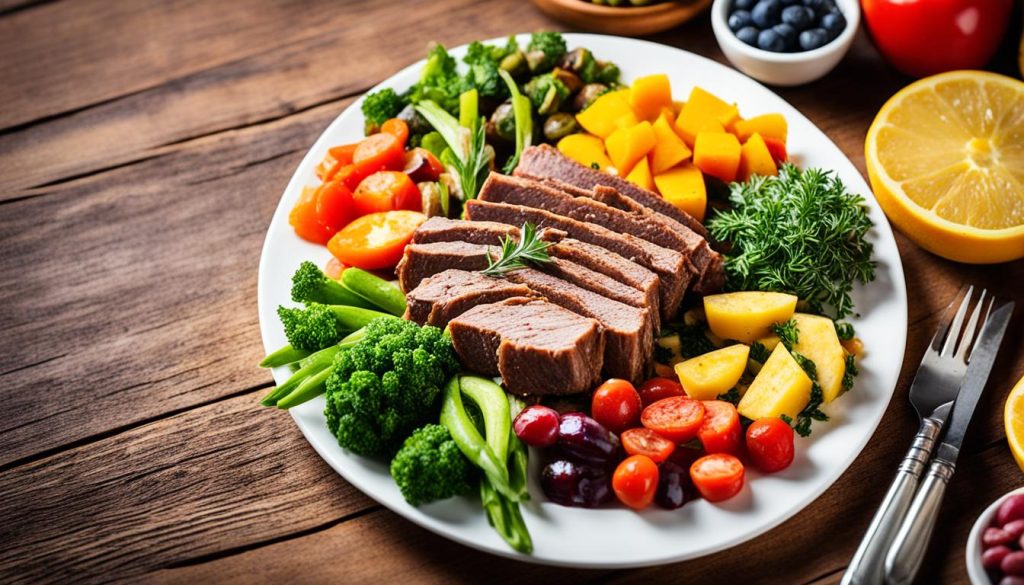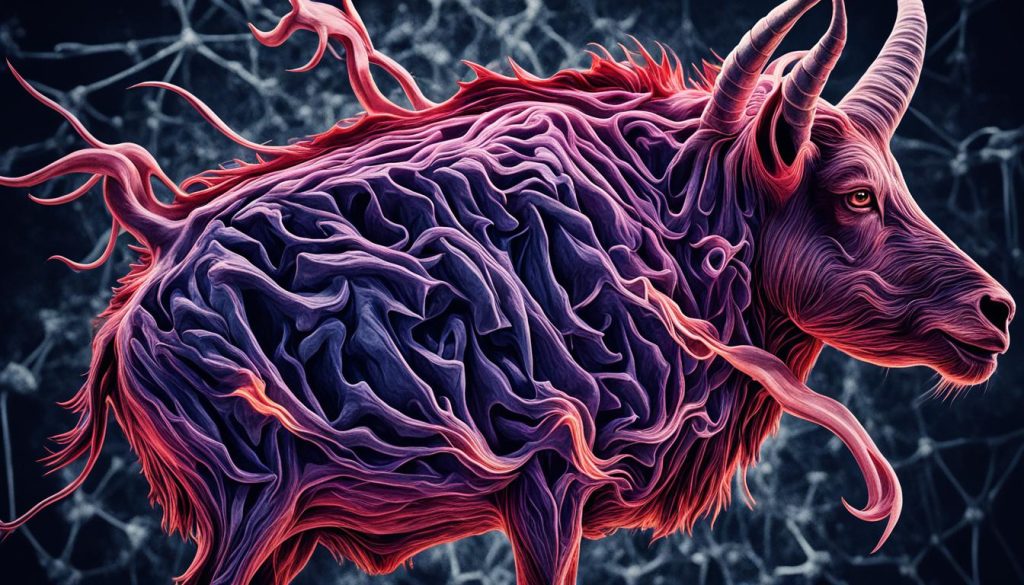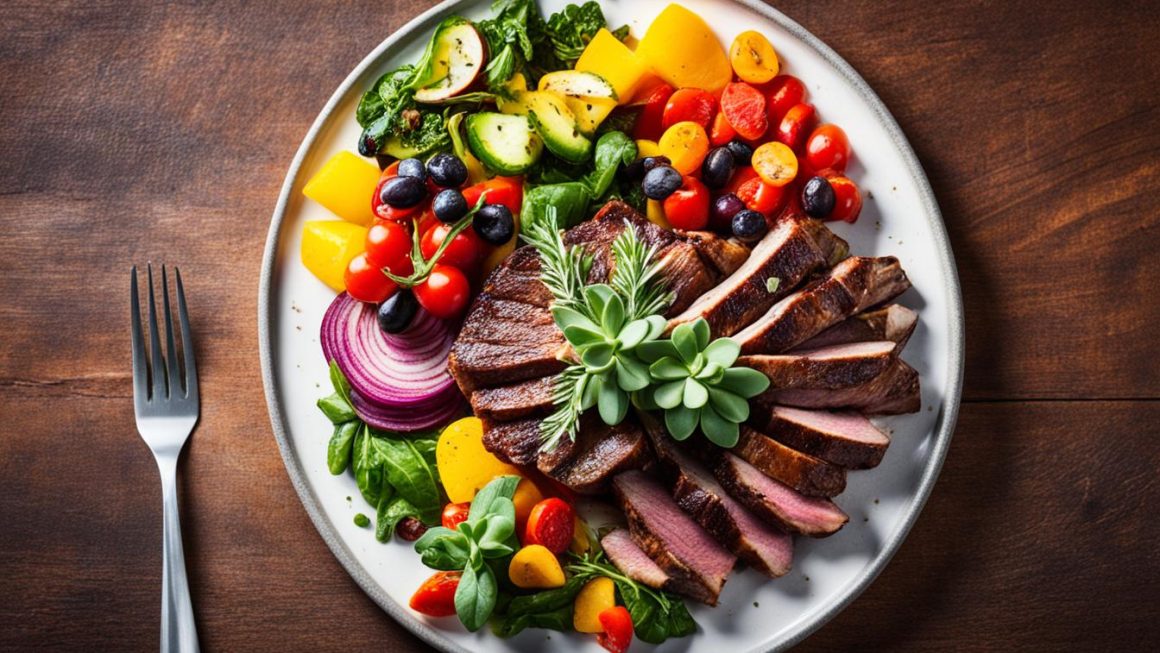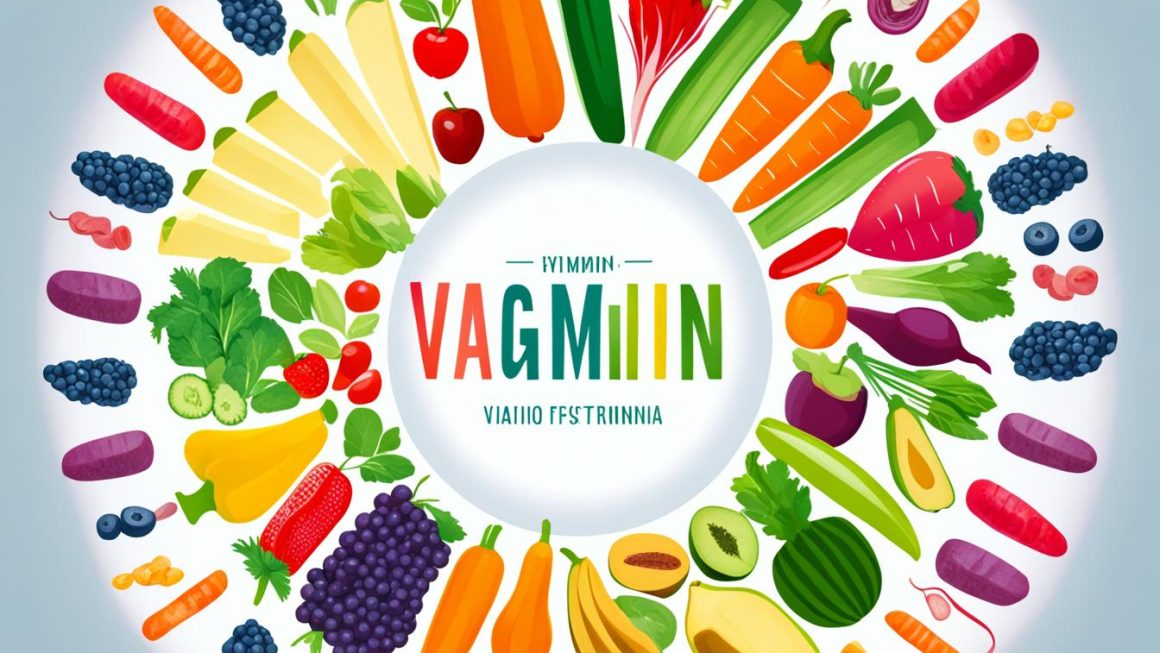Are you looking for a healthier alternative to traditional red meats? Consider goat meat! Not only does it offer a unique flavor, but it also provides numerous health benefits. In this article, we will explore the nutritional advantages of consuming goat meat and why it can be a valuable addition to your diet.
When it comes to nutrition, goat meat has several advantages. Compared to other red meats, goat meat is lower in saturated fat and cholesterol, making it a heart-healthy option. Additionally, it is higher in iron, which is essential for maintaining healthy blood and boosting energy levels. With its rich nutritional profile, goat meat can contribute to a well-balanced and nutritious diet.
One of the great things about goat meat is its versatility in cooking. It can be prepared with a variety of flavors and spices, allowing you to experiment and create delicious meals that suit your taste preferences. Whether you prefer stews, curries, roasts, or grilled dishes, goat meat can be cooked to perfection.
Key Takeaways:
- Goat meat is lower in saturated fat and cholesterol than other red meats.
- It is higher in iron and can contribute to a well-balanced diet.
- Goat meat can be cooked with different flavors and spices to suit your taste preferences.
- It is a versatile meat that can be used in various dishes such as stews, curries, roasts, and grills.
- Including goat meat in your diet adds variety and can provide unique nutritional benefits.
Goat Meat Basics
Goat meat, also known as chevon, is classified based on the age of the goat when the meat is processed. Understanding the basics of goat meat can help you choose the right cut and cooking method for a delicious and satisfying meal.
There are two main categories of goat meat: kid meat and adult meat. Kid meat, also known as capretto, refers to the meat of a goat aged 4 months or less. It is leaner, more tender, and has a milder flavor compared to adult meat.
On the other hand, adult meat, or chevon, comes from a goat up to 14 months old. It has a richer flavor and firmer texture than kid meat. Due to its toughness, adult meat is best suited for slow, moist heat cooking methods, such as braising or stewing, to enhance its flavor and tenderness.
Here’s a breakdown of the age classification for goat meat:
| Age Classification | Description |
|---|---|
| Kid Meat | Goat aged 4 months or less |
| Adult Meat | Goat up to 14 months old |
When it comes to cooking goat meat, the tenderness and age of the meat play a crucial role. Kid meat is versatile and suitable for various cooking methods, including grilling, roasting, and pan-frying. On the other hand, adult meat benefits from slow cooking methods, which help break down the tougher fibers and result in a more tender and flavorful dish.
Breeds of Goat
When it comes to goat breeds, there are several varieties, each serving a different purpose. While some breeds are primarily known for their milk production, others are more suitable for meat consumption. If you are considering raising goats for meat, there are a few common breeds that you should be acquainted with:
- Boer Goat: Originally from South Africa, the Boer goat is a popular choice for meat production. Boer goats are known for their large size, fast growth rate, and excellent meat quality. They have a high meat-to-bone ratio and are prized for their tender, flavorful meat.
- Spanish Goat: The Spanish goat, also known as the “brush” goat, is a hardy breed that is well-suited for meat production. They have a leaner meat compared to the Boer goat but offer excellent flavor. Spanish goats are known for their adaptability to different environments, making them a versatile choice for meat production.
- Brush Goat: The Brush goat, also referred to as the “Spanish” goat, is a common breed for meat consumption in the southern United States. These goats are known for their ability to thrive in harsh environments and are often used for brush control in addition to meat production. They have a distinct flavor that is enjoyed by many.
Each of these breeds has its own unique characteristics and qualities that make them suitable for meat production. Whether you choose the Boer, Spanish, Brush, or another breed, it’s important to consider factors such as adaptability to your climate, growth rate, and desired meat quality.
Take a look at the table below for a quick comparison of these goat breeds:
| Breed | Origin | Size | Meat Quality | Adaptability |
|---|---|---|---|---|
| Boer Goat | South Africa | Large | Excellent | Moderate |
| Spanish Goat | Spain | Medium | Good | High |
| Brush Goat | United States | Medium | Distinctive | High |
As you can see, each breed has its own unique characteristics and advantages for meat production. Understanding the qualities of each breed can help you make an informed decision about the best goat breeds for your meat consumption goals.
Where Goat Meat Is Consumed and How it Is Prepared
Goat meat is widely consumed in diverse cultures around the world, particularly in Asian, African, Caribbean, and Middle Eastern cuisines. It holds a prominent place in the culinary traditions of these regions, offering a unique flavor and versatility in cooking.
In Asian cuisine, goat meat is often featured in various dishes, including curries, stir-fries, and soups. Its tender texture and rich flavor make it a popular choice in countries like India, Nepal, and Indonesia. Goat meat is typically marinated with aromatic spices and herbs to enhance its taste.
In African cuisine, goat meat is a staple and is commonly used in traditional dishes such as goat pepper soup, mutton stew, and grilled goat meat. African countries like Nigeria, Ghana, and Ethiopia have a strong tradition of goat meat consumption, where it is known for its succulent and robust flavor.
Caribbean cuisine also embraces goat meat in many of its signature dishes. Goat curry is a beloved delicacy in countries like Jamaica, Trinidad and Tobago, and Haiti. The meat is slow-cooked with spices and fragrant herbs, resulting in a tender and flavorful dish.
In Middle Eastern cuisine, goat meat plays a significant role in traditional recipes such as shawarma, kebabs, and slow-cooked stews. Countries like Lebanon, Iran, and Saudi Arabia incorporate goat meat into their culinary heritage, relishing its rich and distinct taste.
When it comes to cooking methods, goat meat is best prepared using low and slow techniques to preserve its tenderness and juiciness. Common cooking methods include stewing, braising, roasting, and slow-cooking. These methods allow the meat to become tender, resulting in flavorful and succulent dishes.
To give you a more detailed understanding of the consumption of goat meat across different cultures, here’s a table highlighting its prevalence in various regions:
| Region | Popular Goat Meat Dishes |
|---|---|
| Asia |
|
| Africa |
|
| Caribbean |
|
| Middle East |
|
Goat Meat Nutrition
Goat meat is an excellent source of essential nutrients that are vital for maintaining good health. With a well-rounded nutrition profile, goat meat offers numerous benefits for your body. Let’s take a closer look at the key nutrients found in goat meat:
| Nutrient | Amount per 3-ounce serving |
|---|---|
| Protein | 23 grams |
| Iron | 1.8 milligrams |
| Vitamin B12 | 0.8 micrograms |
| Zinc | 2.2 milligrams |
| Potassium | 235 milligrams |
In addition to its nutrient content, goat meat is also low in total fat and saturated fat compared to other red meats. This makes it a healthier choice for individuals conscious of their fat intake.
Protein is an essential macronutrient that plays a crucial role in building and repairing tissues, supporting the immune system, and aiding in important bodily functions. With 23 grams of protein per 3-ounce serving, goat meat is an excellent source of this vital nutrient.
Did you know? Protein in goat meat is highly digestible and contains all the essential amino acids that your body needs for optimal functioning.
Iron is an important mineral that is necessary for the production of red blood cells and the oxygen-carrying capacity of the blood. Goat meat is rich in iron, with a 3-ounce serving providing approximately 1.8 milligrams of this vital mineral.
Vitamin B12 is essential for various bodily functions, including the formation of red blood cells and the maintenance of a healthy nervous system. Goat meat is a good source of vitamin B12, with a 3-ounce serving containing about 0.8 micrograms.
Zinc is crucial for immune function, DNA synthesis, and cell division. Goat meat provides a significant amount of zinc, with approximately 2.2 milligrams in a 3-ounce serving.
Potassium is a mineral that is essential for maintaining healthy blood pressure, proper fluid balance, and the function of nerves and muscles. A 3-ounce serving of goat meat contains around 235 milligrams of potassium.
With its impressive nutritional profile, goat meat can be a valuable addition to a well-balanced diet, providing essential nutrients that support overall health and well-being.

Goat Meat: A Nutritional Powerhouse
Goat meat not only offers an array of beneficial nutrients but also contributes to a balanced diet. Its protein content aids in muscle development and repair, while its iron content supports healthy blood production. Vitamin B12 in goat meat promotes proper nerve function, and zinc plays a vital role in immunity. Additionally, potassium helps maintain optimal fluid balance and heart health.
By incorporating goat meat into your meals, you can enjoy its nutrition-packed benefits while savoring its unique and delicious flavor. Whether grilled, roasted, or simmered in a stew, there are countless ways to prepare and enjoy goat meat as part of a healthy, nutrient-rich diet.
Health Benefits of Goat Meat
Goat meat is not only delicious, but it also offers a range of health benefits that make it a great addition to your diet. Whether you’re concerned about heart health, diabetes prevention, boosting your metabolism, or supporting your immune system, goat meat has you covered.
One of the key health benefits of goat meat is its low fat and saturated fat content. This makes it an ideal choice for those looking to lose weight or improve heart health. By opting for goat meat instead of other fatty meats, you can reduce your overall saturated fat intake and lower your risk of heart disease.
Additionally, goat meat is rich in iron, an essential mineral that plays a crucial role in energy production and immune support. Iron helps transport oxygen throughout the body and supports the production of red blood cells. By including goat meat in your diet, you can boost your energy levels and strengthen your immune system.
For pregnant women, consuming goat meat can help prevent anemia, a condition characterized by low levels of red blood cells. Anemia during pregnancy can lead to complications for both the mother and the baby. The high iron content in goat meat can help prevent or alleviate anemia, promoting a healthy pregnancy.
Furthermore, goat meat has been found to have anti-inflammatory properties that may provide relief from menstrual pain. Its nutritional profile, including iron and other minerals, can help alleviate cramps and reduce the severity of menstrual discomfort.
Here is a snapshot of the health benefits of goat meat:
| Health Benefit | Description |
|---|---|
| Heart Health | Low in fat and saturated fat, reducing the risk of heart disease. |
| Diabetes Prevention | Can be part of a balanced diet to support blood sugar control. |
| Metabolism Boost | Rich in iron, promoting energy production and metabolism. |
| Immune Support | High in iron, which aids in immune function and red blood cell production. |
| Weight Loss | Lower in fat compared to other red meats, supporting weight management. |
| Anemia Prevention | High iron content helps prevent anemia, especially during pregnancy. |
| Menstrual Pain Relief | Anti-inflammatory properties may help alleviate menstrual discomfort. |
As with any meat, it’s important to choose lean cuts and practice proper cooking techniques to maximize the health benefits of goat meat. Experiment with different recipes and flavors to enjoy this nutritious protein source while reaping its health advantages.
Downsides of Goat Meat
While goat meat is known for its numerous health benefits, it is important to be aware of the potential downsides associated with its consumption. One of the main concerns with goat meat is the risk of food-borne illnesses if the meat is not handled and cooked properly. Cooking goat meat to the recommended internal temperature of 145°F (63°C) can help kill harmful bacteria and reduce the risk of food-borne illnesses such as Salmonella and E. coli.
Furthermore, certain processed goat meat products, such as cured and smoked meats, may have an increased risk of cancer. These products often contain nitrites and nitrates, which can react with amino acids and form cancer-causing compounds called nitrosamines. Limiting the consumption of processed goat meat products can help mitigate this risk.
To ensure the safe consumption of goat meat and minimize the downsides, it is crucial to follow proper food safety practices while handling, storing, and cooking the meat. Here are some tips to consider:
Properly handle raw goat meat: Store goat meat at a safe temperature below 40°F (4°C) and separate it from other foods to prevent cross-contamination. Thoroughly wash hands, utensils, and surfaces that come into contact with raw goat meat to avoid spreading bacteria.
Cook goat meat thoroughly: Use a food thermometer to ensure that goat meat is cooked to the recommended internal temperature of 145°F (63°C) for medium-rare or 160°F (71°C) for medium. Avoid eating undercooked or raw goat meat, which can harbor harmful bacteria.
Limit processed goat meat consumption: Processed goat meat products like sausages, deli meats, and cured/smoked meats should be consumed in moderation to reduce the intake of nitrites and nitrates.
In summary, while goat meat offers various health benefits, it is important to be aware of the downsides associated with its consumption. Proper handling and cooking techniques can help minimize the risk of food-borne illnesses, while limiting the consumption of processed goat meat products can reduce the potential risk of cancer. By following these guidelines, you can enjoy the nutritional advantages of goat meat while ensuring your safety and well-being.

Who Should Avoid Goat Meat
While goat meat offers numerous health benefits, it may not be suitable for everyone. Certain individuals should exercise caution or avoid consuming goat meat altogether due to specific health conditions. Here are some groups of people who should consider avoiding goat meat:
- Individuals with Liver Disease: People with liver disease or liver-related conditions should be cautious about consuming goat meat. Due to its protein content, goat meat may place additional strain on the liver, which can be detrimental to their health.
- Individuals with High Fever: If you have a high fever, it is essential to avoid goat meat. Consuming goat meat during a fever can exacerbate your symptoms and make the recovery process more challenging.
- People with Certain Health Conditions: Individuals with specific health conditions such as phlegm, toothache, ulcers, acne, or hemorrhoids may need to steer clear from goat meat. It’s advisable to consult with a healthcare professional to determine whether consuming goat meat is suitable for your condition.
- Children: Children have developing livers and kidneys that may not handle excessive protein well. Therefore, it is recommended to limit their intake of goat meat. Ensuring a balanced diet is crucial for their overall growth and development.
If you fall into any of these categories, it is advisable to consult with a healthcare professional before including goat meat in your diet. It’s essential to prioritize your health and make informed decisions that align with your specific circumstances.
Remember, while goat meat offers numerous health benefits, it’s crucial to understand its compatibility with your individual health needs.
Cooking Goat Meat
When it comes to cooking goat meat, there are various methods that you can use to create delicious and flavorful dishes. Whether you prefer slow cooking, grilling, roasting, stewing, or pan-frying, each technique offers a unique way to enhance the taste and texture of the meat.
1. Slow Cooking: Slow cooking is one of the most popular methods for preparing goat meat. It involves cooking the meat over low heat for an extended period, allowing it to become tender, juicy, and full of flavor. Slow cooking is ideal for making stews, curries, and other hearty dishes that require long cooking times.
2. Grilling: Grilling goat meat can bring out its natural smoky flavors and create a delicious charred exterior. Marinating the meat beforehand can help to tenderize it and infuse it with additional flavor. Grill goat meat over medium-high heat, turning it occasionally until it reaches the desired level of doneness.
3. Roasting: Roasting is a great method for cooking larger cuts of goat meat, such as roasts or leg cuts. It involves cooking the meat in the oven at a high temperature, which results in a crisp, flavorful exterior and a tender interior. Season the meat with herbs, spices, and marinades to enhance its taste.
4. Stewing: Stewing is another popular method for cooking goat meat. It involves simmering the meat in a liquid, such as broth or sauce, over low heat for an extended period. This slow and gentle cooking process helps to break down the tough fibers in the meat, resulting in a tender and flavorful dish.
5. Pan-Frying: Pan-frying is a quick and simple cooking method that can be used for smaller cuts of goat meat, such as chops or cubes. Heat oil or butter in a pan and cook the meat over medium-high heat until it is browned and cooked to your desired doneness. Pan-frying is a great option when you’re short on time.
Each cooking method offers a different way to bring out the unique flavors and tenderness of goat meat. Experiment with different techniques and recipes to discover your favorite way to cook this versatile and delicious meat.
Bottom Line
Goat meat is a nutritious option that can be a valuable addition to a balanced diet. Its health benefits, including being low in fat and cholesterol, make it an excellent alternative to other red meats. The inclusion of goat meat in your meals can provide essential nutrients such as iron and vitamin B12 while adding variety to your diet. Whether you substitute other meats with goat meat or explore new recipes and cuisines, incorporating this lean and flavorful meat into your meals can contribute to your overall well-being.
Health Benefits of Goat Meat
Goat meat offers numerous health benefits that make it an attractive choice for many individuals. One of its key advantages is its lower fat and cholesterol content compared to other red meats. By opting for goat meat, you can reduce your saturated fat intake while still enjoying a delicious and satisfying protein source. Additionally, goat meat is a significant source of iron, which plays a vital role in cell function and the transportation of oxygen throughout the body. The inclusion of goat meat in your diet can help prevent iron-deficiency anemia and support overall energy production.
“Incorporating goat meat into your diet can provide essential nutrients such as iron and vitamin B12 while adding variety to your meals.”
Vitamin B12 is another nutrient found in ample amounts in goat meat. This essential vitamin is crucial for various bodily functions, including the production of red blood cells and the proper functioning of the nervous system. By including goat meat in your diet, you can meet your vitamin B12 needs without relying solely on other sources such as dairy products or supplements.
Moreover, goat meat is particularly beneficial for individuals looking to maintain a healthy weight. With its lower fat content, it provides a lean protein option that can help support muscle growth and maintenance while keeping calorie intake in check. By incorporating goat meat into your diet, you can promote satiety, making it easier to adhere to a well-balanced eating plan.
Including goat meat in your meals can also contribute to overall immune support. The meat contains essential minerals like zinc and potassium, which are vital for proper immune function and overall health. Zinc plays a crucial role in supporting the immune system’s response to infections, while potassium helps maintain healthy blood pressure levels and supports heart health.
Lastly, goat meat has been lauded for its potential to provide relief from menstrual pain. Certain nutrients present in goat meat, particularly iron, can help alleviate cramps and discomfort associated with menstruation. Including goat meat in your diet during this time of the month may provide some relief and contribute to an overall sense of well-being.
In conclusion, goat meat provides a range of health benefits that make it a valuable addition to a balanced diet. Its lower fat and cholesterol content, coupled with its high nutritional value, make it an excellent choice for individuals looking to enhance their health and well-being. By adding goat meat to your meals, you can enjoy its unique flavor while supporting key aspects of your health, including heart health, weight management, immune function, and more.
Conclusion
In conclusion, the health benefits of eating goat meat make it a nutritious choice for meat consumption. This meat is lower in saturated fat compared to other red meats, making it a healthier option for individuals looking to maintain heart health and manage cholesterol levels. Additionally, goat meat is higher in iron, which is essential for the production of healthy red blood cells and overall energy production.
Furthermore, goat meat provides essential vitamins and minerals such as vitamin B12, zinc, and potassium. These nutrients are important for supporting a strong immune system, maintaining healthy metabolism, and promoting overall well-being.
However, it’s essential to consider certain downsides and factors when consuming goat meat. Improper cooking techniques and handling can pose a risk of food-borne illnesses, highlighting the importance of proper food safety practices. Additionally, individuals with specific health conditions or liver disease may need to restrict their consumption of goat meat due to its protein content.
To fully enjoy the health benefits of goat meat, it’s crucial to practice proper cooking methods and consider personal health circumstances. When prepared correctly, goat meat can be a delicious and nutritious addition to a balanced diet, offering a unique flavor experience and diverse culinary possibilities.
| Advantages of Eating Goat Meat | Disadvantages of Eating Goat Meat |
|---|---|
| Health Benefits | Potential Risks |
|
|
Quote:
Goat meat offers a unique blend of taste, nutrition, and versatility. By including it in your diet, you can enjoy its health benefits and add variety to your meals.
By understanding the advantages and disadvantages of goat meat consumption and making informed choices, individuals can optimize their health and well-being while indulging in delicious and nutritious cuisine.
So, why not explore the culinary world of goat meat and try incorporating it into your diet?
References
Here are the references used in this article:
Scientific Research
- Health benefits of consuming goat meat: a review
- Nutritional composition of goat meat: a review
- Chemical composition and nutritional quality of goat meat: a review
Culinary Magazines
- Cooking Light: How to Cook Goat Meat
- Food & Wine: What Does Goat Taste Like?
Cultural Sources
- Eater: The Essential Guide to Caribbean Cuisine
- Saveur: Mexican Goat Meat
News and Media
- The New York Times: What to Order in Morocco
- BBC Future: Could eating goat save the planet?
Books
- Goat: Cooking and Eating by James Whetlor
- Goat’s Milk and Cheese by Maggie Foard
These sources provided valuable information and insights for the content of this article. Please refer to them for further reading and in-depth knowledge on the topic.
Just One Thing
Looking to add variety to your protein choices while enjoying the health benefits of goat meat? Why not try a new goat meat recipe today? Cooking goat meat with different flavors and spices can result in delicious and nutritious meals that will delight your taste buds.
Goat meat’s unique flavor and versatility make it a great option for experimenting with different cuisines and cooking methods. Whether you prefer slow-cooking in stews and curries, grilling, roasting, stewing, or pan-frying, there’s a goat meat recipe that will suit your preferences.
Try tender, succulent goat meat marinated in aromatic spices and grilled to perfection. Or, indulge in a hearty goat meat stew, infused with rich flavors and slow-cooked to enhance its tenderness.
So next time you’re in the mood for trying something new, give goat meat a chance. Discover the delights of this lean, flavorful meat and reap its health benefits with every bite. Get creative in the kitchen and unlock the culinary potential of goat meat with a tantalizing recipe that will leave you wanting more.



